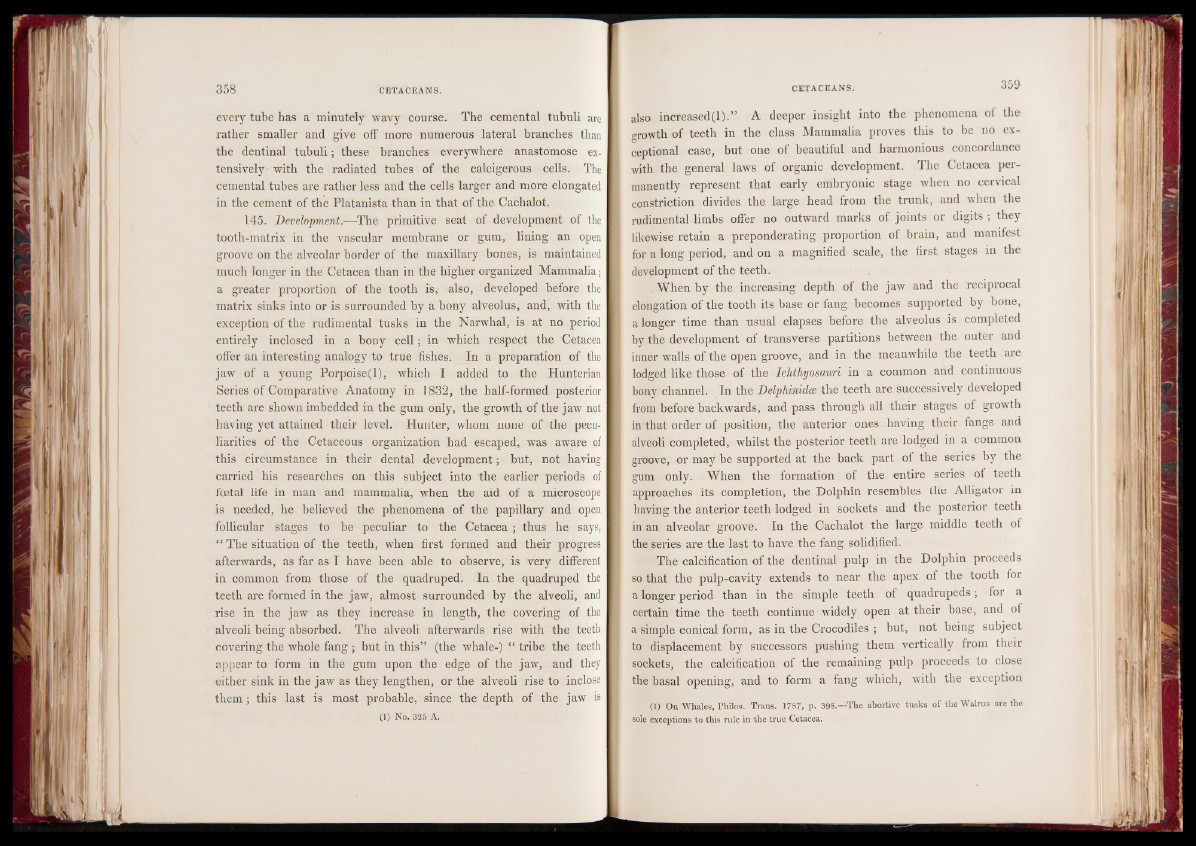
every tube has a minutely wavy course. The cemental tubuli are
rather smaller and give off more numerous lateral branches than
the dentinal tubuli ; these branches everywhere anastomose extensively
with the radiated tubes of the calcigerous cells. The
cemental tubes are rather less and the cells larger and more elongated
in the cement of the Platanista than in that of the Cachalot.
145. Development. T h e primitive seat of development of the
tooth-matrix in the vascular membrane or gum, lining an open
groove on the alveolar border of the maxillary bones, is maintained
much longer in the Cetacea than in the higher organized Mammalia ;
a greater proportion of the tooth is, also, developed before the
matrix sinks into or is surrounded by a bony alveolus, and, with the
exception of the rudimental tusks in the Narwhal, is at no period
entirely inclosed in a bony cell ; in which respect the Cetacea
offer an interesting analogy to true fishes. In a preparation of the
jaw of a young Porpoise(l), which I added to the Hunterian
Series of Comparative Anatomy in 1832, the half-formed posterior
teeth are shown imbedded in the gum only, the growth of the jaw not
having yet attained their level. Hunter, whom none of the peculiarities
of the Cetaceous organization had escaped, was aware of
this circumstance in their dental development ; but, not having
carried his researches on this subject into the earlier periods of
foetal life in man and mammalia, when the aid of a microscope
is needed, he believed the phenomena of the papillary and open
follicular stages to be peculiar to the Cetacea ; thus he says,
“ The situation of the teeth, when first formed and their progress
afterwards, as far as I have been able to observe, is very different
in common from those of the quadruped. In the quadruped the
teeth are formed in the jaw, almost surrounded by the alveoli, and
rise in the jaw as they increase in length, the covering of the
alveoli being absorbed. The alveoli afterwards rise with the teeth
covering the whole fang ; but in this” (the whale-) “ tribe the teeth
appear to form in the gum upon the edge of the jaw, and they
either sink in the jaw as they lengthen, or the alveoli rise to inclose
them; this last is most probable, since the depth of the jaw is
(1) No. 325 A.
also increased(l).” A deeper insight into the phenomena of the
growth of teeth in the class Mammalia proves this to be no exceptional
case, but one of beautiful and harmonious concordance
with the general laws of organic development. The Cetacea permanently
represent that early embryonic stage when no cervical
constriction divides the large head from the trunk, and when the
rudimental limbs offer no outward marks of joints or digits ; they
likewise retain a preponderating proportion of brain, and manifest
for a long period, and on a magnified scale, the first stages in the
development of the teeth.
. When by the increasing depth of the jaw and the reciprocal
elongation of the tooth its base or fang becomes supported by bone,
a longer time than usual elapses before the alveolus is completed
by the development of transverse partitions between the outer and
inner walls of the open groove, and in the meanwhile the teeth are
lodged like those of the Ichthyosauri in a common and continuous
bony channel. In the Delphinidce the teeth are successively developed
from before backwards, and pass through all their stages of growth
in that order of position, the anterior ones having their fangs and
alveoli completed, whilst the posterior teeth are lodged in a common
groove, or may be supported at the back part of the series by the
gum only. When the formation of the entire series of teeth
approaches its completion, the Dolphin resembles the Alligator in
having the anterior teeth lodged in sockets and the posterior teeth
in an alveolar groove. In the Cachalot the large middle teeth of
the series are the last to have the fang solidified.
The calcification of the dentinal pulp in the Dolphin proceeds
so that the pulp-cavity extends to near the apex of the tooth for
a longer period than in the simple teeth of quadrupeds; for a
certain time the teeth continue widely open at their base, and of
a simple conical form, as in the Crocodiles ; but, not being subject
to displacement by successors pushing them vertically from their
sockets, the calcification of the remaining pulp proceeds to close
the basal opening, and to form a fang which, with the exception
(1) On Whales, Philos. Trans. 1787, p. 398.—The abortive tusks of the Walrus are the
sole exceptions to this rule in the true Cetacea.